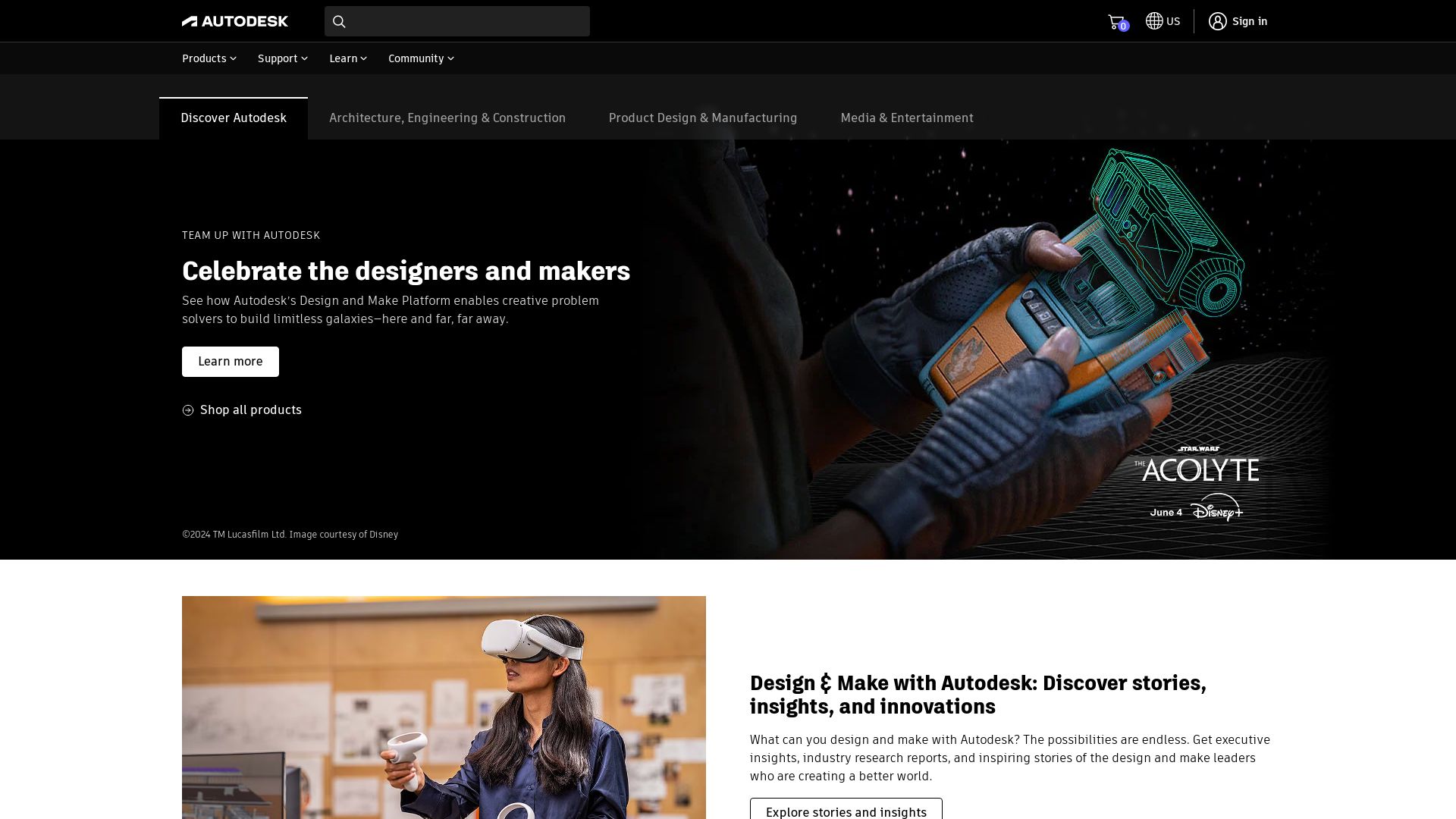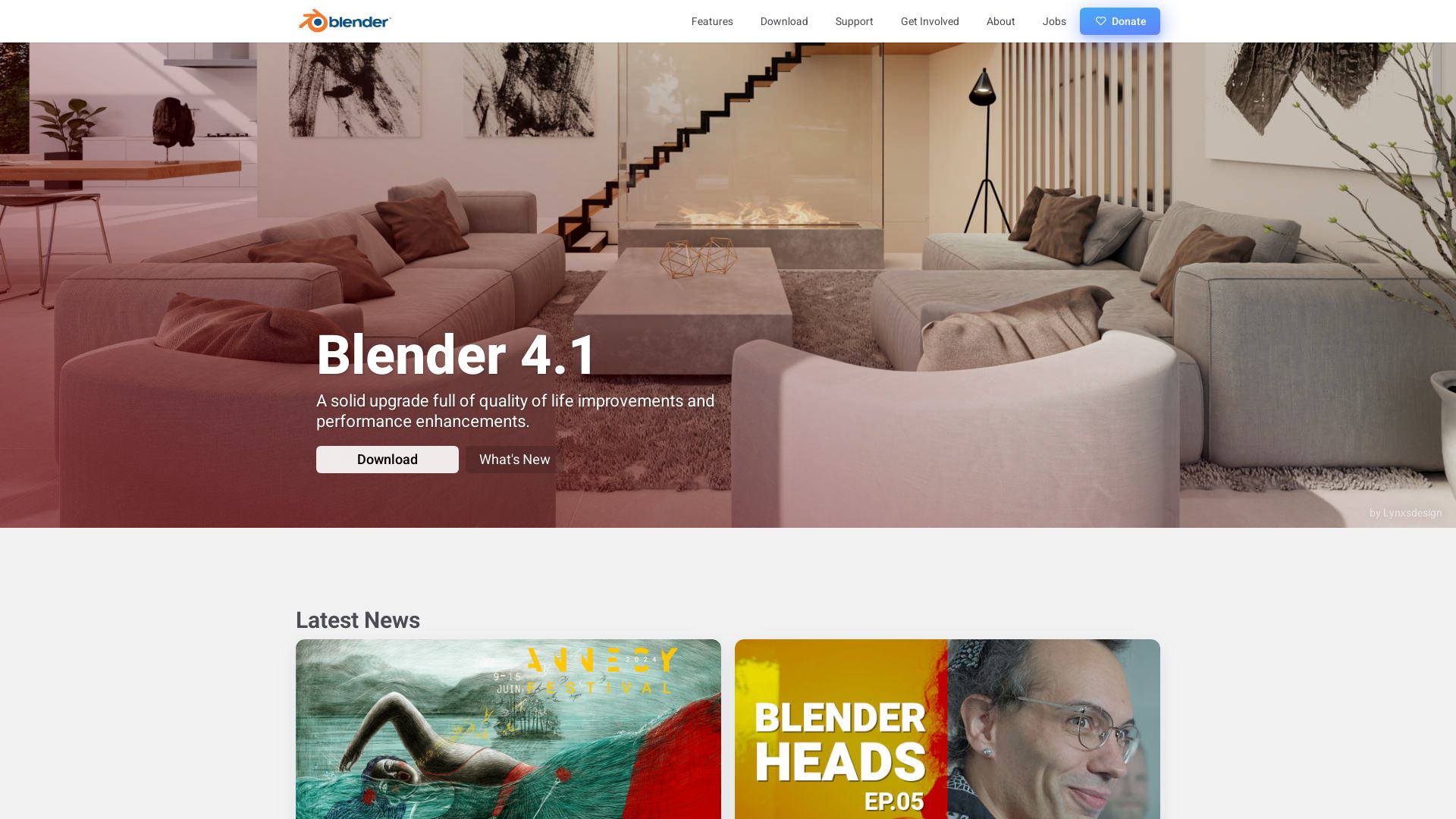AutoCAD LT is a 2D drafting software released by Autodesk, offering essential drafting tools without 3D capabilities. It targets individual users and small teams needing basic collaboration features.

Exploring options beyond AutoCAD LT leads to alternatives such as FreeCAD, a free open-source CAD program favored by some users for its cost-effective nature.
AutoCAD
Autodesk’s AutoCAD is a renowned software application for computer-aided design (CAD) and drafting, used widely to create 2D and 3D drawings. Born in 1982, it was the first CAD system developed for PCs and has been embraced by professionals across various industries including architecture, project management, animation, and engineering.
AutoCAD Best Features
- Conceptualization and accurate design production
- Fast design calculations and simulations
- Supports Application Programming Interfaces (APIs) for customization and innovative feature additions
- Design of vertical products like AutoCAD Architecture, AutoCAD Electrical, and AutoCAD Civil 3D
- Drawing and version history feature that helps track and comprehend design evolution
- Supports multiple file formats including those preferred by most 3D printers
| Feature | Description |
|---|---|
| Launched in 1982 | AutoCAD has a rich history, with 31 versions since its first release |
| Wide Industry Application | AutoCAD is suitable for various industries including fashion, aerospace, aviation, medical devices, and more |
| Integration | AutoCAD integrates seamlessly with other applications such as 3D Max |
AutoCAD Limitations
- May have a steep learning curve for beginners
- Complexity might lead to confusion in commands and features for new users
AutoCAD Pricing
AutoCAD transitioned to a subscription pricing model on August 1, 2016, moving away from selling perpetual licenses. Detailed pricing is available on the official Autodesk website.
AutoCAD Use Cases
Use case 1: Construction
AutoCAD is largely preferred in the construction industry. A notable example is its application in designing the Shanghai Tower, where AutoCAD was crucial in capturing the tower’s twisted structure and facilitating eco-friendly construction.
Use case 2: Entertainment
AutoCAD’s advanced 3D animation capabilities are beneficial for the entertainment industry, aiding in the production of high-quality content.
Use case 3: 3D Printing
With its support for a variety of file formats preferred by most 3D printers, AutoCAD is favorable in the 3D printing industry.
Autodesk

The American multinational, Autodesk, Inc., is a highly reputable software corporation catering to a diverse range of industries including engineering, architecture, manufacturing, media, education, and more. Established in the year 1982 by John Walker and Dan Drake, it continues to serve businesses and professionals around the globe.
Autodesk Top Features
- High-end CAD software: Autodesk’s flagship AutoCAD serves as a spine for architectural, engineering, and structural design.
- Digital Protoyping tools: Inventions such as Autodesk Inventor, Fusion 360, and Autodesk Product Design Suite allow realism-driven visualizations, simulating real-world conditions.
- Diverse Software list: From Revit for building information modeling to Maya and 3ds Max for design visualization, Autodesk’s software menu is quite vast.
| Feature | Description |
|---|---|
| AutoCAD LT | Offers 2D non-specialized applications, with output file formats being DXF and DWG. |
| Software Certificates | Certifications available for Autodesk Certified User and Advanced Certified Professional. |
| Retired Products | Products such as Autodesk Real-Time Ray Tracing Cluster, Autodesk Simulation Mechanical, and Autodesk Stingray. |
Autodesk Limitations
- Despite its steady expansion, the corporation underwent significant layoffs in 2017, indicating possible instability.
- Notably, support for the Unix environment and Apple Macintosh was discontinued post the AutoCAD Release 13.
- Some popular products like Volo View, 3D Studio Max, Lightscape, Sketchbook designer, and Softimage were discontinued.
Autodesk Usage Scenarios
Architecture & Engineering
Flagship software AutoCAD is greatly utilized for designing architectural marvels and engineering wonders, such as the San Francisco Bay Bridge and the Shanghai Tower.
Product Design
Product Design Suite and Autodesk Inventor, backed by robust digital prototyping tools, support designing cutting-edge products, like the electric car models of Tesla.
Media & Entertainment
Softwares 3ds Max, Maya find significant usage in the Animation, Visual Effects, and Game Development arenas, catering to the media and entertainment sectors.
Civil 3D
An innovative product of the Autodesk lineage, Civil 3D is specifically designed for civil infrastructure design and documentation. It has been reshaping the world of civil engineering since its initial release.
Top Features of Civil 3D
- Advanced Design Capabilities: Allows for the creation, modification and publication of comprehensive layouts for roads, bridges, railways, canals, and intersections.
- Data Integration: With compatibility with ESRI ArcMap 10 and Civil Design, it enables seamless data transfer across applications.
- User-friendly Design: Renowned for its intuitive interface and robust performance in topography and related projects.
- Exploration of Design Alternatives: Integrated design and drafting environment supports exploration of different design solutions.
| Supports | Both 2D and 3D CAD, catering to diverse project requirements |
| File Sharing | Enables sharing in .dxf format, simplifying collaboration across teams |
| Cloud-Based Storage | Supported by AutoCAD Mobile and Web, ensuring accessibility and reduced storage constraints |
Limitations of Civil 3D
- Crime Costs:High price point can be a deterrent for small-scale designers or businesses with limited projects.
- Learning Curve: Despite similarities with AutoCAD, new users may find the abundance of features overwhelming and require substantial learning time.
Civil 3D Pricing
While exact pricing details are not provided in the summary given, Civil 3D operates on a subscription model, potentially demanding significant investment. However, a low-cost version, AutoCAD LT, is also available for users with limited requirements.
Civil 3D Use Cases
Infrastructure Projects
Civil 3D can significantly impact productivity in large-scale infrastructure projects, such as designing roads, bridges and canals, thanks to its powerful features and design flexibility.
Spatial Data Management
For geospatial professionals dealing with ESRI ArcMap 10, Civil 3D can seamlessly integrate and manage large datasets, enhancing data visualization and analysis.
Topographical Engineering
When it comes to topographical engineering, Civil 3D excels at capturing detailed geographical features, effectively aiding in thorough terrain analyses and planning.
AutoCAD Architecture
Used by architects, engineers, and construction professionals, AutoCAD Architecture is an influential tool in the realm of architectural design. Its capabilities extend from drafting industry-specific designs to creating detailed 3D models of buildings.
AutoCAD Architecture Top Features
- Architectural renovations, wall, door, window, and room design/documentation. Perfect for complex tasks central to the architectural process.
- DWG compare, save-to-web/mobile, shared views along with an accessible AutoCAD mobile app for iOS, Android, and Windows phones.
- Its compatibility with Building Information Modelling (BIM) makes tracking of changes a breeze.
- For advanced requirements, there are over 8,500 intelligent architectural components coupled with customization options.
| Feature | Description |
|---|---|
| Display System | Objects only drawn once and adjust to various drawing requirements, view directions, and levels of detail. |
| Design Cycle Support | Supports designs from early idea stages to construction-use documents. |
| Sustainability | Central to architectural tasks, supporting creation of durable, ecological, and socially viable buildings. |
AutoCAD Architecture Limitations
- Demanding learning curve, particularly for new users.
- Can be challenging to adopt due to the hefty price.
- Potentially resource-heavy when dealing with large complex building models.
- Occasional technical issues/bugs.
AutoCAD Architecture Pricing
AutoCAD Architecture is available via subscription plans. The monthly plan is priced at $220 while the yearly plan comes at $1,775. You may opt for a three-year subscription, costing you $4,795.
AutoCAD Architecture Use Cases
Use Case 1 : Architects
Architects can leverage powerful, industry-specific tools in AutoCAD Architecture to produce comprehensive floor plans, sections, and elevations. The ability to create 3D building models and customize design elements provides an additional edge.
Use Case 2 : Engineers
Engineers can utilize the vast array of tools present in AutoCAD Architecture, such as the DWG compare function, for reviewing and analyzing design iterations.
Use Case 3 : Construction Professionals
Construction professionals can materially benefit from AutoCAD Architecture. The BIM compatibility aids in efficient management and tracking of changes throughout the design process.
CAD
Recognized as a cornerstone of the digital design world, CAD (Computer-Aided Design) software is instrumental in the creation of both 2D and 3D designs. Incepted by Douglas T. Ross in 1959 and further developed in the 1960s and 1970s, CAD has marked pivotal moments in the realm of automotive and aerospace industries. Additionally, CAD’s wide-ranging utilities extend to architects, engineers, drafters, game designers, and beyond.
CAD Top Features
- 3D Modelling: Modern CAD systems include 3D modelling abilities, providing engineers with a powerful tool.
- CAD/CAM Integration: The fusion of Computer-Aided Design and Computer-Aided Manufacturing directs automated machine tools based on CAD designs, optimizing the workflow.
- Future-proof: CAD software is regularly updated with industry developments and maintains backward compatibility.
- Cloud Collaboration: Onshape’s introduction signified the potential of collaborative CAD tools, driving digital synergy.
- Holographic Display: Microsoft’s HoloLens has revolutionized CAD’s display mechanisms with the capacity for holographic model display.
| Feature | Description |
|---|---|
| IGES Protocol | An early neutral CAD format used for 3D model transfer |
| PRONTO | The first commercial numerical-control programming system, sparking CAD/CAM inception |
| UNISURF | A pioneer 3D CAD/CAM system developed by Renault |
CAD Limitations
- While CAD software utilizes updates to remain future-proof, the need for constant modernization may require consistent learning on part of the user.
- Implementing CAD/CAM can be complex and may involve a learning curve.
CAD Use Cases
Use case 1
A trendsetting force in the automotive and aerospace sectors, CAD is employed in creating detailed 2D and 3D models for parts and assemblies, fostering precision and efficiency.
Use case 2
Increasing productivity in architectural and interior/exterior design, CAD’s 3D modelling capability enables designers to visualize and experiment with spatial layouts and structures.
Use case 3
For game and animation designers, the power of CAD lies in its ability to represent complex geometries and structures, driving the creation of immersive digital worlds.
ArchiCAD

Developed by Hungary’s Graphisoft, ArchiCAD is a Building Information Modeling (BIM) Computer Aided Design (CAD) software boasting robust 2D and 3D drafting functionalities, and catered towards architects, designers, and planners.
ArchiCAD Top Features
- Parametric Objects: Capabilities enable data-enhanced design elements.
- 2D or 3D Representation: Complete design flexibility with high quality rendering capabilities.
- Collaboration: Supports remote global project coordination with its Graphisoft BIM Server.
- Virtual Building Elements: User-friendly tools for creating virtual structural elements like walls, roofs, doors, etc.
- Extensions: Allows software enhancement and application integration.
| File Import/Export Capabilities | Supported API & 3rd Party Plugins |
|---|---|
| DWG, DXF, IFC, BCF files and more | Autodesk Revit, PARAM-O, Datasmith Exporter, Rhino-Grasshopper, etc. |
ArchiCAD Limitations
- Complexity: High feature density can potentially overwhelm new users.
- Localization: May not cater to all global regions equally.
- Proprietary: Not conducive to open-source software preference.
ArchiCAD Pricing
ArhiCAD’s pricing is contingent on several factors, including the chosen plan, number of licenses, and version type, ranging from commercial to educational and trial versions.
ArchiCAD Use Cases
Use case 1: Architecture Firms
ArchiCAD’s BIM functionality offers architecture firms a comprehensive solution for planning, designing, and visualization.
Use case 2: Freelance Designers
Freelance designers can utilize ArchiCAD’s robust 2D and 3D drafting capabilities to bring their designs to life.
Use case 3: Remote Collaborators
Thanks to ArchiCAD’s BIM server, teams spread across geographical locations can seamlessly collaborate on designs in real-time.
Fusion 360
A product of Autodesk, Fusion 360 is an integrated, cloud-based platform used extensively in the fields of design, engineering, electronics, and manufacturing. Released on September 24, 2013, it’s known for its simplicity and superior functionality on multiple operating systems.
Fusion 360 Top Features
- Integrated Software: Combines CAD, CAM, CAE, and PCB design under one roof.
- Advanced Design Capabilities: Offers state-of-the-art 2D and 3D designing, PCB layouts, and simulation capabilities.
- Streamlined Workflow: Seamless cloud integration for efficiency and collaboration.
- Topological Shape Optimisation: Optimize and iterate designs smoothly with advanced features.
- Consistent Updates: Keeps pace with industry demands with regular feature updates.
| Pros of Fusion 360 | Cons of Fusion 360 |
|---|---|
| Affordable pricing and flexible direct modelling | Potential malware risks |
| User-friendly interface and integrated electronics | Lack of personalized keyboard controls |
| Large community for support and online learning resources | No web-based standalone version |
Fusion 360 Limitations
- Potential risks of malware attacks.
- Lack of personalized keyboard controls.
- No standalone version for web-based operation available.
Fusion 360 Pricing
With an affordable annual subscription of $545/ year or $70/month, Fusion 360 offers unparalleled value, making it especially popular among SMEs.
Fusion 360 Use Cases
Use case 1: Electronics
Fusion 360’s sophisticated PCB design and simulation functions make it an excellent resource for the electronics industry.
Use case 2: Aesthetic Design
Designers seeking realistic rendering and comprehensive tools for aesthetic design will find Fusion 360 to be a dependable ally.
Use case 3: Architecture
Architects can leverage Fusion 360’s advanced 2D & 3D designing tools to bring their visions to life with precision and ease.
Blender

In the grand theater of 3D computer graphics, Blender steps onto the stage, an open-source superstar wielding a comprehensive toolset for a symphony of creative applications. Born in the thoughtful minds at the Dutch animation studio NeoGeo, it made its debut on January 2, 1994, and has tirelessly evolved through open-source development, fueled by a passionate community and guided by the vision of its main developer, Ton Roosendaal.
Blender’s Best Features
- 3D modelling: Create, modify, and transform your 3D masterpieces.
- UV mapping and texturing: Add intricate details and ultra-realistic textures to your 3D models.
- Rigging and skinning: Bring your creations to life with dynamic movement and realism.
- Fluid and smoke simulation: Create hyper-real environments and effects.
- Rendering: Use the Eevee renderer for stunning visual outputs.
- Video editing and compositing: Perfectly polish your animated footage.
| Digital Drawing and Raster Graphics Editing | Add artistic texture and detail to your works with precision and control. |
| Animation and Match Moving | Create fluid animations and match movements with uncanny realism. |
| Support for multiple import/export 3D file formats | Flexibility for cross-platform work including Alembic, 3DS, FBX, DXF and others. |
Blender’s Limitations
- The Blender Game Engine is deprecated as of the 2.8 release.
- The original Blender Internal was removed in favor of the Eevee renderer in the 2.80 release.
- The learning curve might be steep for novice users due to its comprehensive tools and features.
Blender Pricing
Donning the noble armor of openness and sharing, Blender is free for all to use. As an open-source software initiative, it continues to thrive under the auspices of the Blender Foundation, ensuring that creativity and innovation remain unrestricted by financial boundaries.
Blender Use Cases
Use case 1 – Animated Films
Blender’s comprehensive animation tools and effects make it an ideal choice for creating compelling animated films.
Use case 2 – Visual Effects
From smoke and fluid simulations to intricate mappings and textures, Blender excels in crafting high-quality visual effects.
Use case 3 – Virtual Reality
Blender’s support for interactive 3D applications positions it as a potent ally in the terrain of virtual reality development.
Grant Sullivan
Content writer @ Aircada and self proclaimed board game strategist by day, AI developer by night.





